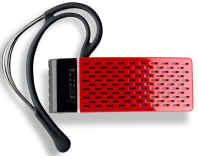Did you think broadcast TV was going away, replaced by subscriptions to hundreds of channels of cable service, and then Internet TV? But broadcast is coming back, not only with digital TV, but also with like TV service to mobile phones.
 You already can get popular TV channels with the Sprint TV service, and subscribe direct from MobiTV to watch 30-some live TV channels on mobile phones or PDAs (and on your computer).
You already can get popular TV channels with the Sprint TV service, and subscribe direct from MobiTV to watch 30-some live TV channels on mobile phones or PDAs (and on your computer).
But you can imagine that the cellular carriers are not enthused about the idea of having their data networks swamped by masses of mobile subscribers continuously streaming different video content. The answer, of course, is to replace our phones with yet another service to bring real live TV, broadcast directly to your phone like the good old days of TVs with antennas.
One was to avoid this whole problem is to offer content only in chunks, with time outs from streaming for the network as you select each clip to play. This is how you use the Apple iPhone to play clips from YouTube.
 It's also the model for the Verizon Wireless V CAST Video service, which offers recent edited highlights of news, sports, popular shows (like the Daily Show from Comedy Central), and music concerts. Think of clips for a newscast or sports wrap-up show -- not live TV, but recent updates.
It's also the model for the Verizon Wireless V CAST Video service, which offers recent edited highlights of news, sports, popular shows (like the Daily Show from Comedy Central), and music concerts. Think of clips for a newscast or sports wrap-up show -- not live TV, but recent updates.
But for real live TV, a better answer is to take the demands of continuous streaming off the cellular data network, and move to a broadcast model for the mass-market content. All this requires is deploying a parallel network on cellular towers that can broadcast a core group of the same 20-some popular channels live, to be received as digital TV by all mobile subscribers simultaneously. With most popular content off the standard cellular data service, it's still available for our own personal uses and more niche content.
The two formats driving this idea are QUALCOMM MediaFLO, particularly in the U.S., and DVB-H (Digital Video Broadcast-Handheld), particularly overseas.
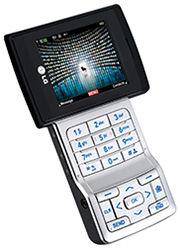 Verizon Wireless has introduced the MediaFLO service in the U.S. as V CAST Mobile TV (press release), launched in major U.S. markets this year. The service currently includes eight channels of scheduled live content and other programming for mass audiences (CBS, Fox, NBC, MSNBC News, Comedy Central, ESPN, MTV, Nickelodeon).
Verizon Wireless has introduced the MediaFLO service in the U.S. as V CAST Mobile TV (press release), launched in major U.S. markets this year. The service currently includes eight channels of scheduled live content and other programming for mass audiences (CBS, Fox, NBC, MSNBC News, Comedy Central, ESPN, MTV, Nickelodeon).
The Mobile TV service runs on the LG VX9400 phone, with a swing bar design -- a large color LCD screen (~ 2 1/4") that swivels for landscape TV viewing.
I tried out the Verizon Mobile TV service in New York City recently (it's not available in central New Jersey yet), and got good reception around the city. The signal started up relatively quickly (10 seconds or so), and channel changes took a few seconds, equivalent to today's digital TVs. The picture was great on the LG VX9400, and particularly when swiveled to landscape mode many of the text crawls at the bottom of the screen were quite readable, including on news channels and ESPN poker broadcasts.
The TV reception did fail inside a building near Battery Park at the bottom of Manhattan, though it did come in intermittently when standing by the outside windows. And there was no reception on a train under Penn Station -- even though the Verizon 1X and EV-DO signals are still quite strong there. (It would be nice to have a signal strength meter for the broadcast signal as well.) But when the train emerged out of the tunnel on the New Jersey side, the TV signal ran great almost all the way to Newark.
See my Mobile Communications Gallery for details and related products.
 Find the Verizon Wireless / LG VX9400 on Amazon.com
Find the Verizon Wireless / LG VX9400 on Amazon.com

![]() Find Adobe Premiere Elements 4 on Amazon.com
Find Adobe Premiere Elements 4 on Amazon.com



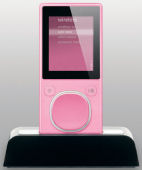 Plus, the line adds two models with flash memory, the Zune 4 and 8 GB ($149 and $199), available in pink, green, black, and glossy red. The screens are 1.8", but still 320 x 240, and they weigh 1.7 oz.
Plus, the line adds two models with flash memory, the Zune 4 and 8 GB ($149 and $199), available in pink, green, black, and glossy red. The screens are 1.8", but still 320 x 240, and they weigh 1.7 oz.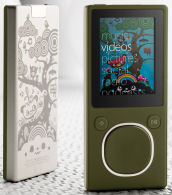
 You already can get popular TV channels with the
You already can get popular TV channels with the  It's also the model for the
It's also the model for the  Verizon Wireless has introduced the MediaFLO service in the U.S. as V CAST Mobile TV (
Verizon Wireless has introduced the MediaFLO service in the U.S. as V CAST Mobile TV (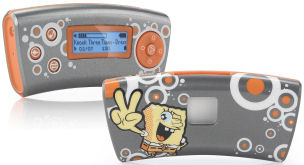 - The simple Fission Digital Music Player for $49 has an easy-to hold design with a slight curve, at 3.6 x 0.7 x 1.7 inches. It plays MP3 and WMA formats, including protected WMA files.
- The simple Fission Digital Music Player for $49 has an easy-to hold design with a slight curve, at 3.6 x 0.7 x 1.7 inches. It plays MP3 and WMA formats, including protected WMA files. 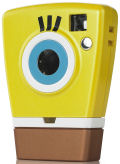 - The compact SpongeBob SquarePants Flash Micro Digital Camera for $19 features a striking yellow SpongeBob eyeball design, has a small LCD used for a few digits of status information, plus a built-in USB connector on the bottom.
- The compact SpongeBob SquarePants Flash Micro Digital Camera for $19 features a striking yellow SpongeBob eyeball design, has a small LCD used for a few digits of status information, plus a built-in USB connector on the bottom. 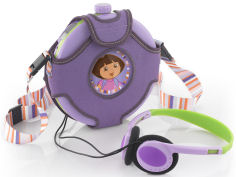
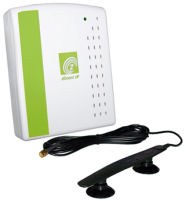 We tried out the zBoost zPersonal (zP), which creates a cell zone of 4 to 6 feet radius, for a single user (one call at a time), and works with both cellular bands ($169).
We tried out the zBoost zPersonal (zP), which creates a cell zone of 4 to 6 feet radius, for a single user (one call at a time), and works with both cellular bands ($169).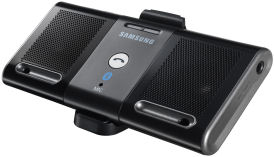 The new
The new 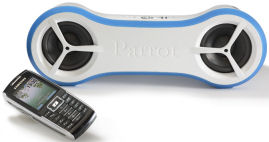 But for less controlled enviroments, you can step up the
But for less controlled enviroments, you can step up the 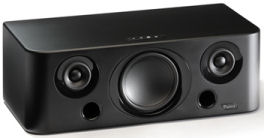 -
- 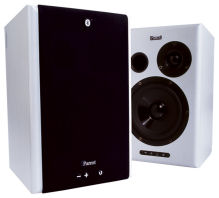 -
-  -
- 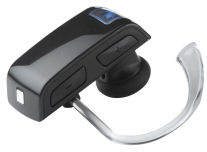 For example, the
For example, the  Which is the idea behind the
Which is the idea behind the 